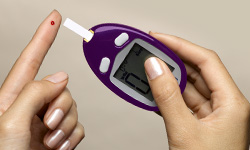The eyes are organs that, although very complex, seem to be ignored until problems actually start to arise. When was the last time you worried about getting the proper nutrients needed to maintain healthy vision? Whether it’s for work or play, many people spend hours a day texting on phones, typing on laptops, or on e-readers. Prolonged use of these technologies can not only cause eye strain, but can also cause an array of symptoms such as tension headaches, burning or tired eyes, blurred vision, etc. This may even accelerate age related eye diseases.
As we age should we just accept that we will have vision loss? Paying attention to what you eat and getting proper supplementation can help support eye health at any age and lower the risk of developing these diseases. Let’s take a closer look at common eye conditions seen today.
Cataracts
Cataract is a clouding of the eye’s lens and is the leading cause of blindness worldwide, and the leading cause of vision loss in the United States. (1) Cataracts can even be present at birth. By age 80, more than half of all Americans either have a cataract or have had cataract surgery. (1) The lens, which focuses light, lets us see both close-up and far away. It is made of mostly protein and water. Some of the protein may clump together and start to cloud a small area of the lens. This is a cataract.
Over time, the cataract may grow larger and cloud more of the lens, making it harder to see. Cataracts glow slowly, so the earlier you begin preventing eye disease the sooner you can slow, if not stop, the progression.
Macular Degeneration
Macular Degeneration causes central field vision loss which makes it difficult to see objects clearly and impairs your ability to complete common daily tasks such as reading, driving and even recognizing faces. It’s the leading cause of permanent impairment of reading and detailed or close-up vision among people aged 65 years and older. (2)
There are two types of macular degeneration, a dry form and a wet form. The dry form is more common and accounts for 70–90% of cases and progresses more slowly than the wet form.
- Dry macular degeneration is characterized by light-sensitive cells in the macula slowly breaking down. The macula is centered in the retina (tissues on the back of your eyeball).
- Wet macular degeneration occurs rapidly when blood vessels under the retina begin leaking blood and fluid. All individuals with wet macular degeneration, started with dry macular degeneration.
One of the most common early signs of macular degeneration is drusen. Drusen are yellow deposits made up of lipids and can be located under the retina. They may be the result of the eye’s failure to eliminate its waste products.
Diabetic Retinopathy
Diabetic Retinopathy is caused by complications of diabetes and can eventually lead to blindness. It affects up to 80 percent of all patients who have had diabetes for 10 years or more. (3)
As the disease progresses, the glucose in your body can damage and even block the blood vessels that nourish the retina, depriving several areas of the retina from their blood supply. The body may then attempt to create new blood vessels. However these fragile, often abnormal blood vessels can easily leak blood into the center of the eye, blurring vision.
Eye support
Foods to eat to support eye health
- Omega 3 rich foods
- Salmon, tuna, olive oil, walnuts
- Green leafy vegetables that contain Lutein as natural occurring carotenoid
- Kale, spinach, collard greens, green peas
- Eggs: Be sure to include the yolk which is the prime source of lutein and zeaxanthin, also a carotenoid
- Almonds (preferably raw and unsalted): Rich in Vitamin E
Daily supplements to consider for eye support
- Fish oil: 500 mg
- Vitamin C: 3000 mg
- Vitamin D: 5000 mg
- Lutein: 10 mg
- Bilberry: 200 mg
- Vitamin E: 400 mg
Risk factors are common amongst most eye diseases, if not all. Smoking and alcohol use, high blood pressure, increased cholesterol levels and diabetes or high sugar levels and all heighten your risk level for developing an eye disease. Controlling these risk factors can put you in control of protecting your vision.
By eating a proper diet rich in nutrients and supplementing with proper vitamins and minerals, you won’t only be protecting your vision but you will also be preventing or controlling the diseases that accompany vision loss such as high cholesterol and diabetes.
When was the last time you had a comprehensive check? Do you know your glucose and hemoglobin A1C numbers? How about your cholesterol levels? When was the last time you had your blood pressure checked or a urine test to look for signs of diabetes, kidney involvement or infection? It’s easier than you might think to get a complete nutritional analysis!
Don’t know where to start? Get a comprehensive blood analysis and tissue mineral analysis to know exactly what you need to optimize your deficiencies and toxicities. Your diet and lifestyle habits do affect your eye health!
References:
- National Eye Institute. http://www.nei.nih.gov/healthyeyes/aging_eye.asp. Accessed on August 21, 2013
- Center of Disease Control. Vision Health Initiative. April 23, 2013. http://www.cdc.gov/visionhealth/basic_information/eye_disorders.htm Accessed on August 21, 2013
- Kertes PJ, Johnson TM, ed. (2007). Evidence Based Eye Care. Philadelphia, PA: Lippincott Williams & Wilkins. ISBN 0-7817-6964-7.

